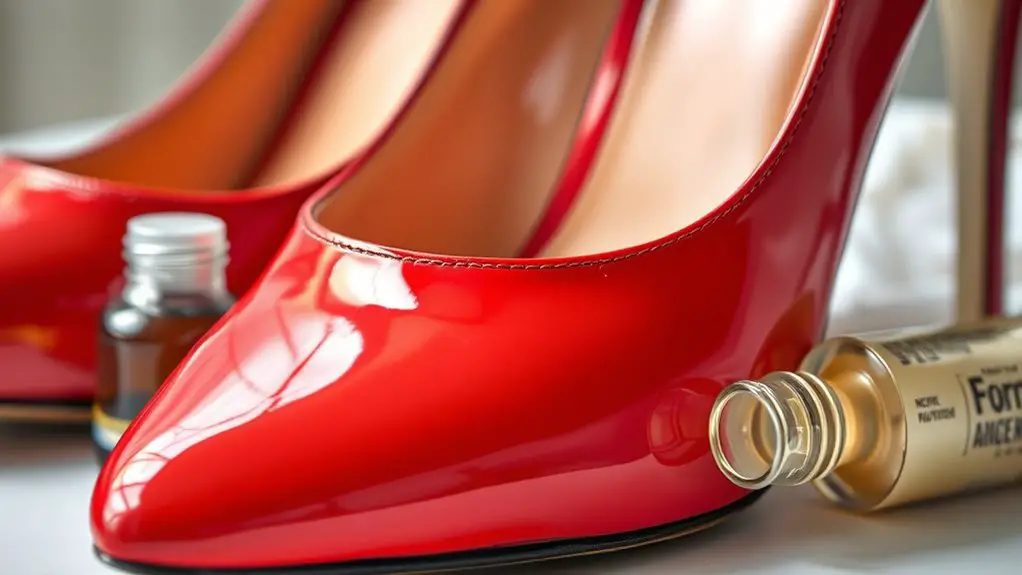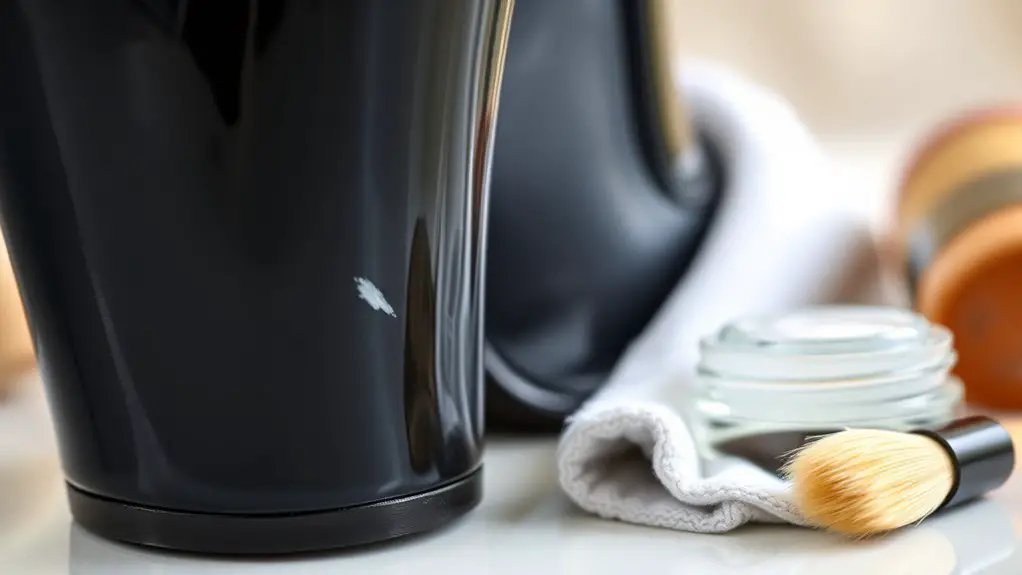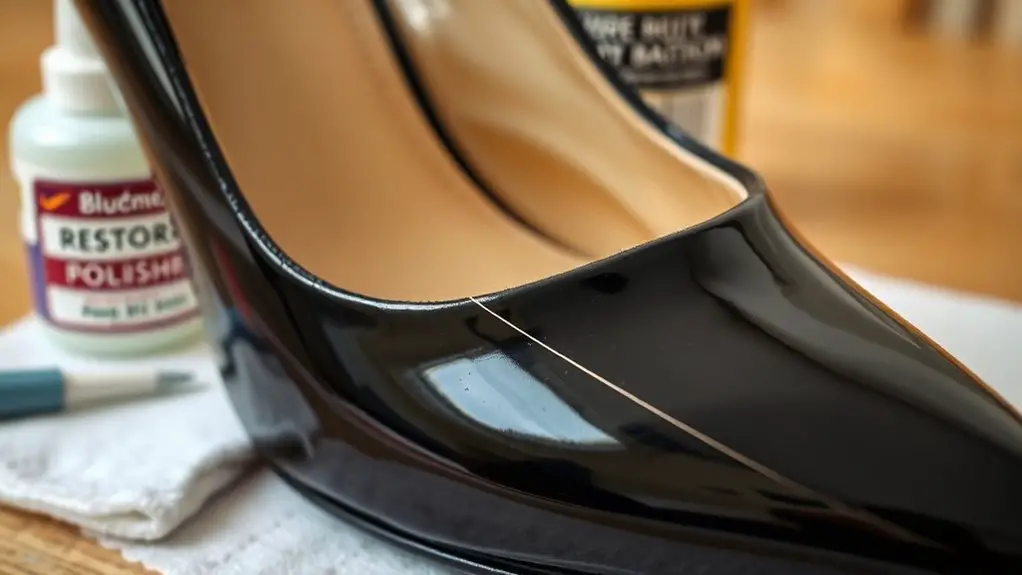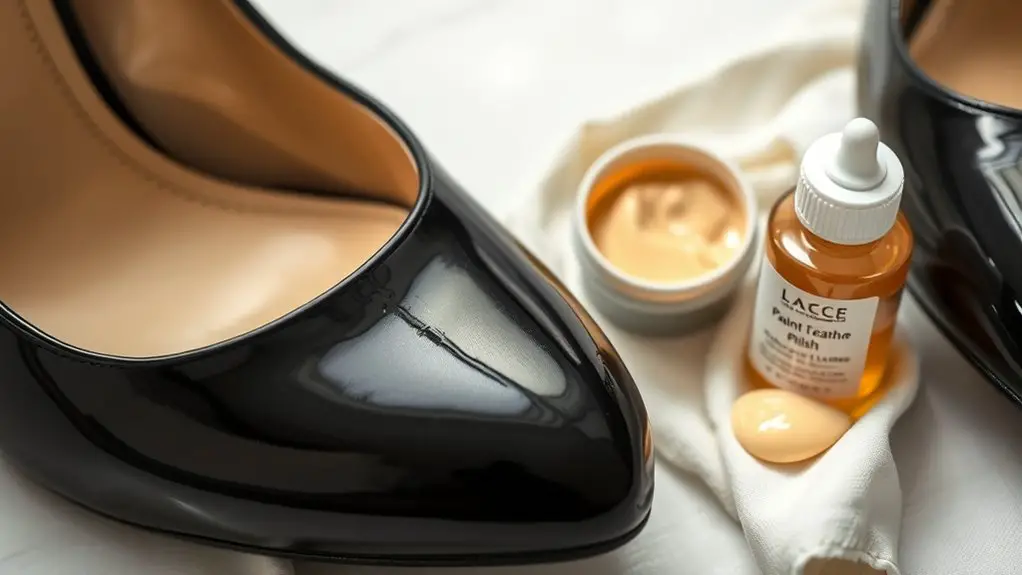To fix scratches on patent leather heels, first clean the area with a soft cloth and mild soap solution. For minor scratches, you can apply high-quality patent leather polish and buff with a microfiber cloth. If scratches persist, gently sand with fine-grit sandpaper, then match and apply polish. For deeper scratches, consider using clear nail polish as a temporary fix. Remember to take preventive measures to protect your heels from further damage. Explore additional repair methods for long-lasting results.
Understanding Patent Leather and Its Vulnerabilities

Patent leather is a unique material prized for its high-gloss finish and sleek appearance, but it comes with its own set of vulnerabilities. Understanding patent leather characteristics is essential for maintaining its aesthetic appeal. The glossy surface, while eye-catching, is prone to scratches from everyday wear. Common scratch causes include friction against rough surfaces, improper storage, and accidental impacts. Even minor elements like gravel or uneven pavement can damage the finish.
Additionally, exposure to harsh chemicals or excessive sunlight can degrade the protective coating, making it easier for scratches to occur. While patent leather is often favored for its stylish look, it requires careful handling and maintenance to avoid unsightly blemishes. By being aware of these vulnerabilities, you can take proactive steps to minimize damage and keep your patent leather heels in pristine condition.
Essential Tools for Scratch Repair
To effectively restore the glossy finish of your patent leather heels, having the right tools on hand is vital. Start with a soft microfiber cloth to gently buff the surface without causing further damage. For deeper scratches, a high-quality patent leather polish is important; it’ll help blend the scratch with the surrounding area. A small, fine brush is also handy for applying the polish precisely.
Additionally, consider using a clear nail polish as a temporary fix for minor scratches; it can seal and protect the area. You’ll want a cotton swab for detailed application of this polish, ensuring you don’t over-apply.
Lastly, a leather conditioner can help maintain the overall integrity of your heels, keeping them supple. With these vital tools, you’re well-equipped to tackle scratch repair and restore your patent leather shoes to their original shine.
Cleaning Your Patent Leather Heels

Before attempting any scratch repair, it’s essential to guarantee your patent leather heels are clean. Proper cleaning not only enhances the appearance but also prepares the surface for effective scratch repair. Here are some effective cleaning techniques to maintain your patent leather:
Ensure your patent leather heels are clean before scratch repair to enhance their appearance and effectiveness.
- Use a soft, damp cloth: Wipe the surface gently to remove dirt and grime without damaging the finish.
- Mild soap solution: Mix a few drops of gentle soap with water, dampen a cloth, and clean any stubborn spots carefully.
- Dry and buff: After cleaning, use a dry microfiber cloth to polish the heels, restoring their shine.
Incorporating these maintenance tips into your routine keeps your patent leather heels looking pristine. Regular cleaning prevents dirt buildup and helps prolong the life of the material, ensuring your heels are always ready for any occasion.
DIY Methods to Fix Scratches
Once your patent leather heels are clean and shining, you can focus on repairing any scratches that may have marred their surface. One effective DIY method is the sanding technique. Gently sand the scratched area using fine-grit sandpaper, being careful not to damage the surrounding finish. After sanding, it’s essential to match the color of your patent leather. You can achieve this by applying a matching polish or paint to the affected area.
Here’s a quick reference table for different methods:
| Method | Steps | Pros |
|---|---|---|
| Sanding Technique | Sand, clean, color match | Effective for deep scratches |
| Polish Application | Apply polish, buff | Quick touch-up |
| Heat Method | Use a hairdryer, smooth over | Works for minor scratches |
| Vinegar Solution | Mix vinegar with water, wipe | Natural cleaner |
| Clear Nail Polish | Apply to scratch, let dry | Temporary fix |
Using Store-Bought Products for Restoration

Although DIY methods can be effective, using store-bought products for restoring patent leather heels often yields quicker and more reliable results. Investing in the right products can help you achieve a polished look with minimal effort. Here are some options to contemplate:
- Scratch repair kits: These kits typically include specialized solutions designed to fill in and conceal scratches, ensuring a smoother surface.
- Restoration creams: Formulated to rejuvenate the patent leather finish, these creams can restore luster and color, making your heels look almost new.
- Cleaning wipes: Pre-moistened wipes can help remove dirt and grime, preparing your shoes for the restoration process.
When using these products, follow the manufacturer’s instructions carefully for the best outcome. With the right approach and the right tools, you’ll have your patent leather heels looking pristine in no time.
Preventive Measures to Protect Your Heels
To maintain the pristine condition of your patent leather heels, establishing a regular cleaning routine is essential. Additionally, utilizing protective sprays can shield the surface from scratches and scuffs. Finally, proper storage techniques will further safeguard your investment, ensuring they remain in excellent shape for years to come.
Regular Cleaning Routine
Implementing a regular cleaning routine is essential for maintaining the pristine appearance of your patent leather heels. To guarantee they remain in top condition, adhere to a consistent cleaning frequency and follow these maintenance tips:
- Wipe them down: Use a soft, damp cloth to remove dust and dirt after each wear.
- Inspect regularly: Check for scuffs or scratches, addressing them immediately to prevent further damage.
- Store properly: Keep your heels in a cool, dry place, away from direct sunlight to avoid discoloration.
Use Protective Sprays
Protecting your patent leather heels from scratches and scuffs is key to their longevity, and using a high-quality protective spray can be an effective measure. These sprays create a barrier against dirt and moisture while enhancing the glossy finish of your shoes.
Here’s a quick guide to help you choose the right product and application techniques:
| Protective Spray | Application Technique |
|---|---|
| Waterproof Spray | Hold 6-8 inches away, spray evenly |
| Scuff-Resistant Spray | Apply in a light, circular motion |
| UV Protection Spray | Allow to dry completely before wearing |
Make sure to follow the manufacturer’s instructions for best results. Regular use of protective sprays will help keep your patent leather heels looking fabulous for years to come.
Store Properly
After investing in protective sprays, how you store your patent leather heels can greatly impact their condition. Proper shoe storage and climate control are essential for maintaining their shine and preventing damage. Here are some best practices for storing your heels:
- Use dust bags: Keep your heels in breathable dust bags to avoid scratches and dust accumulation.
- Maintain ideal temperature: Store them in a cool, dry place, ideally between 60°F and 75°F, to prevent warping.
- Avoid stacking: Store your heels upright or on a shoe rack to avoid pressure and maintain their shape.
When to Seek Professional Help
While many minor scratches on patent leather heels can be addressed with at-home remedies, there are instances when professional help is not just advisable but necessary. You should consider consulting a professional if you notice significant scuffs or cracks that go beyond surface-level scratches. Signs of damage like discoloration, peeling, or a loss of shine indicate that your heels require expert attention. Additionally, if you’ve attempted DIY fixes without success, it’s a clear signal that a professional repair might be the best route. Remember, improper handling can worsen the damage, potentially leading to irreversible changes in the material. A cobbler or specialized leather care service can assess the condition accurately and provide effective treatments tailored to your heels. Investing in professional help not only restores your footwear’s appearance but also prolongs its lifespan, ensuring you get the most out of your fashionable investment.
Frequently Asked Questions
Can I Use Regular Shoe Polish on Patent Leather?
You shouldn’t use regular shoe polish on patent leather; it’s designed for matte finishes. For proper leather maintenance and shoe care, opt for a specialized patent leather cleaner to maintain its shine and prevent damage.
How Do I Know if My Scratches Are Too Deep to Fix?
To assess your scratches, evaluate their depth visually. If they’re shallow, repair techniques like polishing may suffice. However, deep scratches might require professional help, as they’re often beyond simple home remedies to restore the original finish.
Will Fixing Scratches Change the Color of My Heels?
Fixing scratches can affect your heels’ color restoration, depending on the method used. Some techniques may alter the original hue, while others minimize scratch visibility without significant color change. Always test on a discreet area first.
Can I Prevent Future Scratches With a Protective Spray?
Oh, sure, protective sprays magically prevent all scratches! While they won’t eliminate every risk, incorporating protective measures and regular maintenance tips can certainly help reduce wear and tear on your beloved patent leather heels.
Is It Safe to Use Heat on Patent Leather for Repairs?
Using heat application on patent leather isn’t recommended, as it can damage the material. Instead, explore safer alternatives for repairs to maintain the integrity and shine of your patent leather items. Caution is essential.



